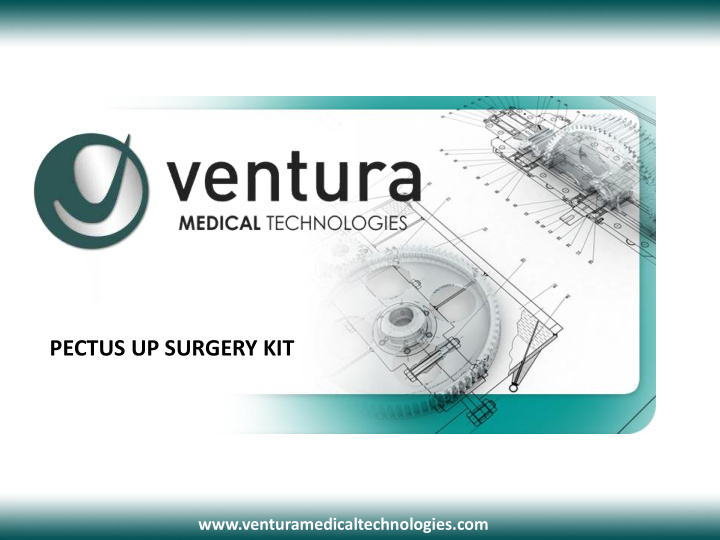



PECTUS UP SURGERY KIT www.venturamedicaltechnologies.com
INTRODUCTION Pectus Excavatum Pectus Excavatum Most frequent deformation of the chest wall in childhood and adolescence, adopting a funnel chest shape ( 1 in 400-500 births, more common in males). Due the complexity of the intervention*, currently only 25% of cases are operated on, which carry health problems,) Disorder caused by a deficiency in the growth of the costal cartilages. As age advances and the chest grows, the cartilages pull the sternum inside and the sinking of the chest is more pronounced. Breathing problems (severe restriction of pulmonary ventilation), heart (shortfall in the filling of blood into the right chambers of the heart), spine (scoliosis), psychological disorders . The treatment is surgical correction. Haller Index Index to measure the severity of the malformation. It is calculated by dividing the distance between the sternum and the spine. With current surgical techniques only cases with a rate >3.5 Haller are operated on because it involves a serious functional disorder. There are extremes cases in which the rate is above 10. *Due to the complexity, risk and type of surgery, neither mild cases nor for esthetic reasons are operated on. www.venturamedicaltechnologies.com
COMPARATIVE Current techniques THECNIQUE DESCRIPTION ADVANTAGES DISADVANTAGES -Very Invasive -Rigid chest -Invasive technique. -Correction of the malformation -Significant surgical trauma: blood loss -This procedure is to remove cartilage, -Painful procedure -Tested method connecting the ribs to the sternum RAVITCH and introducing a bar in the rear of the -Documented Results -Leaves considerable scars on the patient's chest sternum. -Surgery at any age -Many hours of surgery -Long-term hospital stays -Requires long stays in intensive care -Correction of the malformation -Risk of perforation of the heart or other internal -Less invasive technique than Ravich. organs with the introduction and removal of the bar. -Less invasive -This procedure involves an -Risk of Pneumo-hemothorax. introduction of a steel concave bar -Minimal blood loss NUSS under the breastbone and during the -Requires intensive care -Much shorter recovery time surgery proceeds to rotate the bar. It can be removed after several years. -Long hospital stays -Small lateral incisions -Medication and postoperative analgesia www.venturamedicaltechnologies.com
COMPARATIVE Taulinoplastia TECHNIQUE DESCRIPTION ADVANTAGES DISADVANTAGES - Minimally invasive. - New innovative device: extrathoracic procedure. - Minimal blood loss. Minimally invasive technique. - Very short recovery. - No risk of damaging intrathoracic organs. Involves raising the sternum - New innovative device: few cases made yet. TAULINOPLASTIA applying a pulling force on it, but - Shorter duration of surgery. without going into the ribcage, - Shorter average length of stay. avoiding possible complications - Minimal incisions. - Postoperative period in intermediate care. - The device could be maintained in perpetuity. www.venturamedicaltechnologies.com
BENEFITS Pectus Up INTERVENTION Less anesthesia Shorter time operating room PROFESSIONAL / THE HOSPITAL Shorter hospital stays Minor pain medication Easy of implementation Less blood loss Less risk No UCI is required Minimally invasive No use of the thoracoscope Less anesthesia No serious surgical or postoperative Lower costs complications No mortality PATIENT Less dangerous Fewer hospital stays Less medication Less pain www.venturamedicaltechnologies.com
DESCRIPTION Surgical technique of Pectus Up THORAX MODEL Sternum 1. Intervention area Cartilage Ribs 2. Incisions to perform during the intervention 3. Drilling of the sternum 4. Subcutaneous introduction of the plate 5. Placement of the lifting system 6. Extraction of the screw 7. Fixing of the plate 8. Final result of the operation www.venturamedicaltechnologies.com
Recommend
More recommend